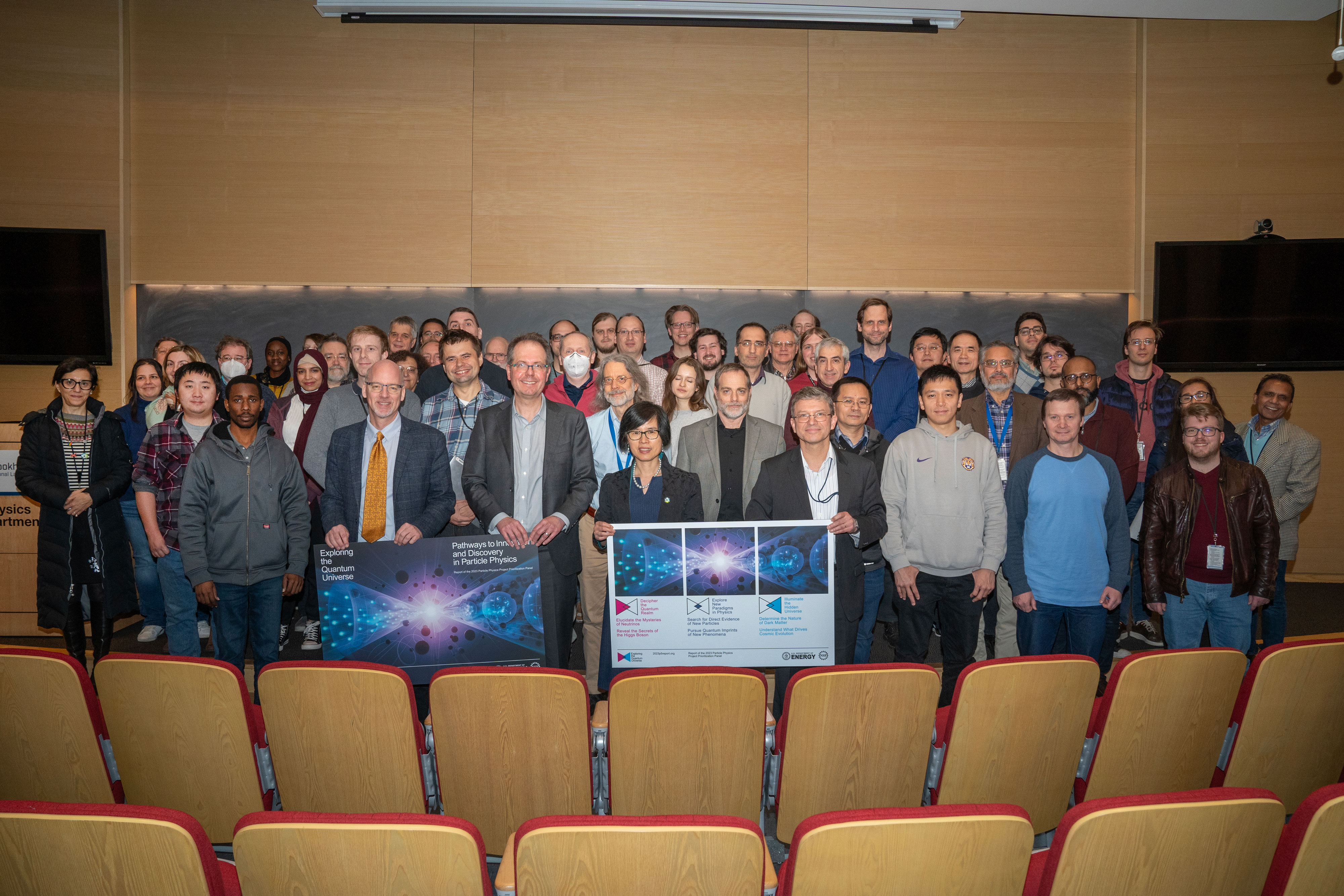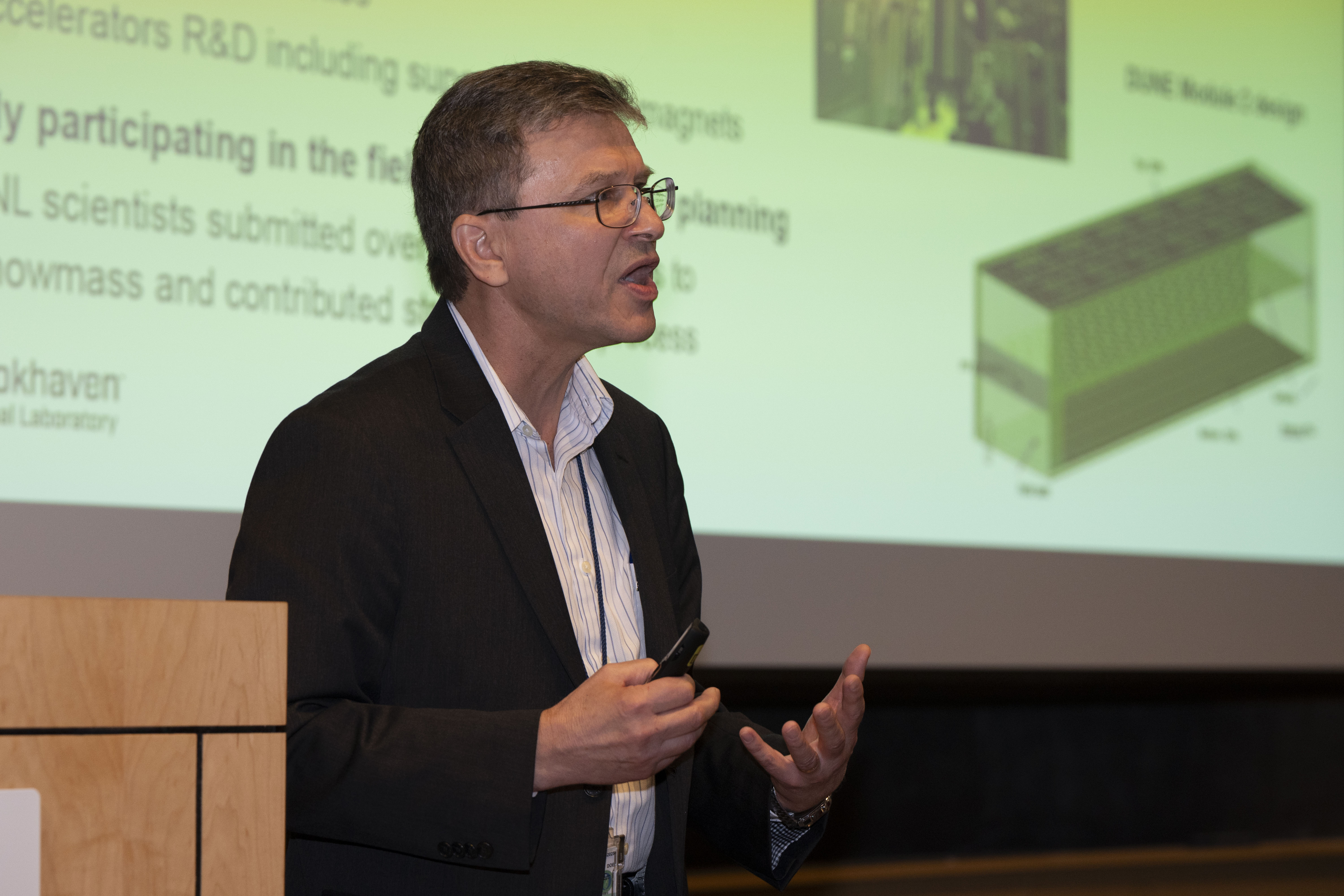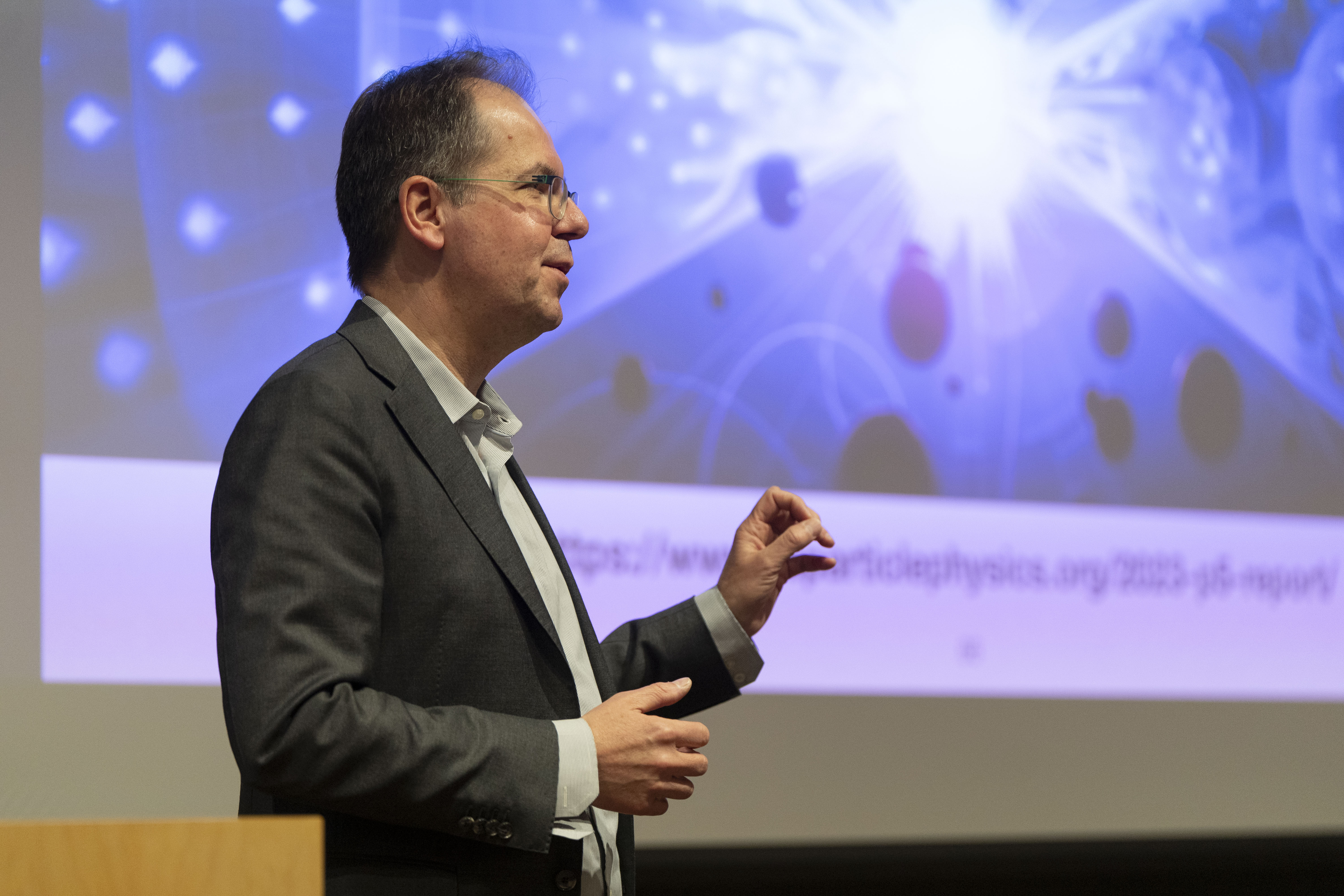Newswise — As the particle physics community releases its strategic plan for the next 10 years and overall vision for the next 20, scientists at the U.S. Department of Energy’s (DOE) Brookhaven National Laboratory have started planning how the Lab is positioned to contribute to a range of the plan’s science goals, new experiments, proposed research facilities, and ongoing projects.
This forward look for particle physics as a whole is outlined in the 2023 Particle Physics Project Prioritization Panel (P5) report released by the High Energy Physics Advisory Panel (HEPAP)—a group that advises DOE and National Science Foundation (NSF) on experimental and high energy physics—on Dec. 7, 2023. The panel identified three science themes, each with two science drivers:
“Brookhaven Lab is involved in all six of these science drivers,” Deputy Associate Laboratory Director for High Energy Physics Dmitri Denisov said during a presentation at Brookhaven about the report’s rollout on Dec. 15.
Denisov said there is strong support in the P5 report for Brookhaven’s ongoing high energy physics program and expertise in other areas the Lab is already actively involved in, including theory, detectors, and accelerator research and development. These projects cover recommendations in the 2023 report, which also emphasizes continued implementation of the P5 recommendations previously delivered in 2014.
“Brookhaven Lab is deeply involved in many activities that are recommended to move forward in the report, and there’s excellent potential for leadership and participation in new programs and experiments that P5 supports,” Denisov said. “That puts us in a very strong position.”
Brookhaven’s Deputy Director for Science and Technology John Hill, who kicked off the presentation, thanked Lab staff for taking part in the exciting P5 process.
“It’s really important and really gratifying to see that we are so engaged in this process,” Hill said.
Brookhaven Lab’s P5 Outlook
Brookhaven Lab is the lead lab for the U.S. ATLAS collaboration, which helps operate the ATLAS particle detector at CERN’s Large Hadron Collider (LHC). Brookhaven also hosts a computing facility that serves as the central hub for distributing ATLAS experimental data among scientists across the country and around the world. ATLAS and Brookhaven scientists contributed to a major moment for the field—the discovery of the Higgs boson in 2012.
The latest P5 report reaffirms a commitment to unlocking the secrets of the Higgs boson—a fundamental piece of the Standard Model of particle physics—in part by supporting high-luminosity upgrades to the LHC. Brookhaven Lab helps produce and test magnets and develops computing and software needs for the upgrades.
Brookhaven Lab also aims to be involved in an international effort to explore the feasibility and design of a proposed “Higgs Factory,” based in either Europe or Japan, to advance studies of the Higgs particle, Denisov noted. The P5 panel emphasized that the field operates on a global scale and requires international cooperation in this endeavor.
Karsten Heeger, P5 panel deputy chair and Eugene Higgins Professor and chair of physics at Yale University, noted that the report is aggressive on accelerator research and development including for a U.S.-based muon collider that could benefit multiple science drivers.
“Accelerator R&D is important for preparing us for the future, identifying what are the possible pathways towards a 10 tera electron volt parton center of mass energy collider and what direction we should also take with an offshore Higgs factory,” Heeger said. “This is also of particular interest at Brookhaven, where there is accelerator expertise, and with the construction of the Electron-Ion Collider, we were very aware of the possible synergies between accelerator R&D and particle physics and nuclear physics.”
Another P5 priority is to study neutrinos—tiny and elusive particles—with precision. Brookhaven Lab is a key partner in the Deep Underground Neutrino Experiment (DUNE) based at Fermilab. The experiment will send intense beams of neutrinos through 800 miles of Earth’s crust and use detectors and advanced software to capture signals that may elucidate neutrino characteristics. Mary Bishai, a Brookhaven physicist, serves as co-spokesperson for DUNE, and Brookhaven scientists are leading the design of a third underground detector module as part of a re-envisioned second phase of DUNE.
“The P5 report is a strong endorsement of DUNE, both phase one and phase two,” Bishai said. “This gives DUNE’s U.S. contribution a solid foundation to start realizing the international effort for a third detector and upgraded near detector complex.”
On the cosmic frontier, the P5 report highlights several studies aimed at shedding light on dark matter and the evolution of the early universe. One is the Legacy Survey of Space and Time (LSST), which will use a telescope containing the world’s largest digital camera at the Vera C. Rubin Observatory in Chile to offer an unparalleled wide-field astronomical survey of our universe—wider and deeper in volume than all previous surveys combined. Brookhaven Lab led construction of the camera’s 3.2 gigapixel digital film—the biggest charge-coupled device array ever built.
Brookhaven is also the lead lab for U.S. collaborators in the ongoing Belle II experiment based at Japan’s SuperKEKB particle accelerator. The experiment is among projects that P5 notes are important in the search for new physics phenomena, including to investigate the decays of heavy quarks. Tracking these decays could reveal undiscovered particles that might explain matter-antimatter discrepancies. Groups at Brookhaven have provided software and computing support as well as magnets, and they also perform data analysis for the experiment.
P5 also recommends that funding agencies invest in programs that foster a supportive, collaborative work environment, help recruit and retain diverse talent, and reinforce professional standards.
“People are the most important asset we have in the field,” Heeger said.
Mark Palmer, director of Brookhaven’s Accelerator Science & Technology Initiative, served on P5 and pointed out that the panel’s 30 members had a strong representation of early career scientists. He noted that these younger scientists will likely be the ones carrying out the report’s recommendations.
“We are looking out to a 20-year time horizon with the charge the panel was given, and it was important to consider the interests of the members of our field who will be finishing up their careers, potentially, on that timeframe—where they want us to move as a whole,” Palmer said.
Balancing Science Goals and Budgets
The Particle Physics Community Planning Exercise, or “Snowmass”, held in 2021 and 2022 was a major source of input for P5’s strategic plan. Brookhaven scientists submitted more than 130 white papers to the meeting, Denisov said. There were also a series of town hall P5 meetings, one of which was hosted by the Lab this year, lab visits, and other communications to gather input on what the field’s priorities should be. The report acknowledges that there were more project proposals than could be accommodated in the budget scenarios P5 had to consider, so difficult choices had to be made, Heeger said.
“This was a balancing exercise,” Heeger said. “Looking at the size and time scale of projects, we wanted to make sure there was a healthy balance between projects in the U.S. and abroad, projects versus research, and of course looking at how we can invest now and what we can do in the future.”
P5 also strove for balance between small, medium, and large-scale projects and created a subcommittee to review the costs, technical risks, and schedule of large projects. These assessments gave the panel confidence in projecting out the field’s focus areas for the next decade, Heeger said.
Going forward, Brookhaven Lab will continue to develop its approach for carrying out the plan, working closely with DOE and NSF.
Palmer and others stressed the importance of the community uniting behind the report’s recommendations:
“I think we need to work together, look at the vision, embrace the vision, and make that vision clear to our peers, to the funding agencies, and to Congress as we move forward so that we can enable a bright future for the field,” he said.
Brookhaven National Laboratory Director JoAnne Hewett expressed her support in an earlier statement: “We welcome the P5 report recommendations, which define a strong and balanced U.S. particle physics program based on input from the Snowmass community-wide process,” she said. “Building on our decades of expertise in high energy physics and facility design and operation, we are eager to actively engage and lead in developing, constructing, and operating the next generation of facilities and experiments to explore the quantum universe.”
Brookhaven National Laboratory is supported by the Office of Science of the U.S. Department of Energy. The Office of Science is the single largest supporter of basic research in the physical sciences in the United States and is working to address some of the most pressing challenges of our time. For more information, visit science.energy.gov.
Follow @BrookhavenLab on social media. Find us on Instagram, LinkedIn, X, and Facebook.



